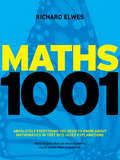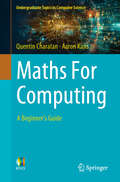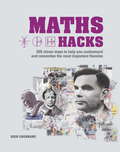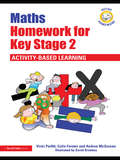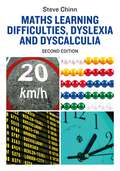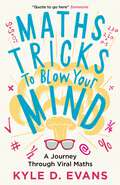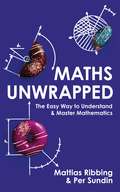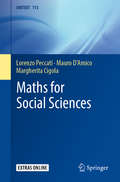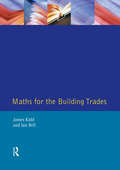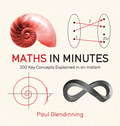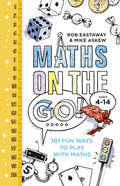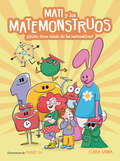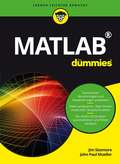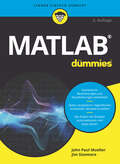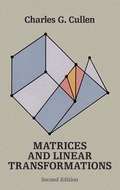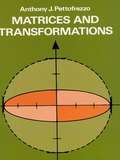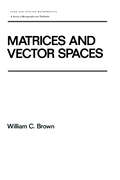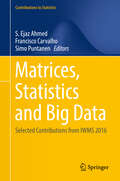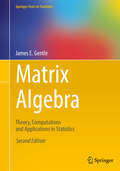- Table View
- List View
Maths 1001: Absolutely Everything That Matters in Mathematics
by Richard Elwes Dr Richard ElwesThe ultimate smart reference to the world of mathematics - from quadratic equations and Pythagoras' Theorem to chaos theory and quantum computing.Maths 1001 provides clear and concise explanations of the most fascinating and fundamental mathematical concepts. Distilled into 1001 bite-sized mini-essays arranged thematically, this unique reference book moves steadily from the basics through to the most advanced of ideas, making it the ideal guide for novices and mathematics enthusiasts. Whether used as a handy reference, an informal self-study course or simply as a gratifying dip-in, this book offers - in one volume - a world of mathematical knowledge for the general reader. Maths 1001 is an incredibly comprehensive guide, spanning all of the key mathematical fields including Numbers, Geometry, Algebra, Analysis, Discrete Mathematics, Logic and the Philosophy of Maths, Applied Mathematics, Statistics and Probability and Puzzles and Mathematical Games. From zero and infinity to relativity and Godel's proof that maths is incomplete, Dr Richard Elwes explains the key concepts of mathematics in the simplest language with a minimum of jargon. Along the way he reveals mathematical secrets such as how to count to 1023 using just 10 fingers and how to make an unbreakable code, as well as answering such questions as: Are imaginary numbers real? How can something be both true and false? Why is it impossible to draw an accurate map of the world? And how do you get your head round the mind-bending Monty Hall problem? Extensive, enlightening and entertaining, this really is the only maths book anyone would ever need to buy.
Maths For Computing: A Beginner's Guide (Undergraduate Topics in Computer Science)
by Quentin Charatan Aaron KansThis introductory textbook covers all the mathematical concepts necessary for a computing degree, limiting coverage only to the material needed for the fundamentals of computing rather than delving into the higher mathematical concepts. Key features include: Gears content toward students who are less confident in mathematics Provides exercises, with solutions, at the end of each chapter Teaches topics using everyday language Includes numerous worked examples in every chapter Uses familiar scenarios to introduce mathematical concepts Discusses the relevance of each chapter topic to the world of computing Core topics covered include: Set and groups Matrices Relations and functions Logic and proofs Combinatorics Probability Graph theory The book is written for students embarking on an undergraduate or foundation degree course in computer science (or related discipline) and aims to provide the basic skills and knowledge of discrete mathematics required for such a course. Whereas many textbooks tend to teach this subject in a way that is more suitable for mathematicians, this text specifically targets first-year students on computing courses and aims to teach only the basic material that they will need for their computing degree. Dr Quentin Charatan is a former Principal Lecturer and now visiting lecturer at the University of East London, UK. Dr Aaron Kans is the Head of the Computer Science and Digital Technologies Department in the School of Architecture, Computing & Engineering at the same institution.
Maths Hacks
by Richard CochraneEverything you need to know about 100 key mathematical concepts condensed into easy-to-understand sound bites designed to stick in your memory and give you an instant grasp of the concept.On each topic, you'll start with a helicopter overview of the subject, which will give you an introduction to the idea and some context surrounding it. Next, you'll zoom in on the core elements of the theory, with clear explanation of each point to make sure you really understand the concept, along with simple examples that everyone can follow. Finally, you'll be given a one-liner hack to really make the theory stick in your mind. The perfect introduction to algebra, logic, probability and much more, this is a great new way to learn about the most important mathematical ideas and concepts in a way that makes them easy to recall even months after reading the book.Topics covered include:NumbersAlgebraLogicGeometryProbabilityComputer scienceApplied mathematicsMechanicsStatisticsSet Theory
Maths Hacks (Hacks)
by Richard CochraneEverything you need to know about 100 key mathematical concepts condensed into easy-to-understand sound bites designed to stick in your memory and give you an instant grasp of the concept.On each topic, you'll start with a helicopter overview of the subject, which will give you an introduction to the idea and some context surrounding it. Next, you'll zoom in on the core elements of the theory, with clear explanation of each point to make sure you really understand the concept, along with simple examples that everyone can follow. Finally, you'll be given a one-liner hack to really make the theory stick in your mind. The perfect introduction to algebra, logic, probability and much more, this is a great new way to learn about the most important mathematical ideas and concepts in a way that makes them easy to recall even months after reading the book.Topics covered include:NumbersAlgebraLogicGeometryProbabilityComputer scienceApplied mathematicsMechanicsStatisticsSet Theory
Maths Homework for Key Stage 2: Activity-Based Learning (Active Homework)
by Colin Forster Vicki Parfitt Andrea McGowanMaths Homework for Key Stage 2 is a unique resource for busy teachers – a selection of ‘pencil-free’, hands-on activities that teachers can use as extension activities or give to pupils as homework to do with members of their family or friends. Each of the activities encourages the pupils to learn through discussion and through practical activities utilising everyday resources. Each activity is quick and easy for pupils and teachers to manage, and includes: a learning aim full, clear instructions and discussion points tasks to develop collaboration and partnership between pupils, parents and teachers photocopiable resources. A refreshing approach for teachers and pupils, these activities will foster enthusiasm for learning and inspire pupils' interest in Maths.
Maths Learning Difficulties, Dyslexia and Dyscalculia: Second Edition (Dyslexia Essentials Ser.)
by Steve ChinnWritten by a world authority on maths difficulties in children, this accessible guide provides tried and tested visual strategies and tailored techniques to help teachers and parents support children with SpLDs who need help with maths.Drawing on the latest research, into areas such as cognition and meta-cognition, along with the authors' decades of teaching experience, the book offers insight into how maths learning difficulties, including dyslexia, dyscalculia and maths anxiety, make maths difficult. Each chapter looks at foundational areas of maths learning that children may struggle with, from early number experiences to basic addition and subtraction, times tables, measurement and more. Essential reading for any teacher, learning assistant or parent supporting children with maths.
Maths Magic class 1 - Andhra Pradesh Board
by State Council of Educational Research and Training Andhra PradeshThis book has 9 chapters. Narrate the stories and answer the questions. Children focus on Rhymes andExercises.
Maths Tricks to Blow Your Mind: A Journey Through Viral Maths
by Kyle D EvansFrom the infamous 'Hannah's sweets' exam question to percentages 'life-hacks', viral math problems seem to capture the public's imagination without fail. This is often because they blow people's minds with their logic, or there are multiple answers, or no answer or at all, or they are just generally wacky. The same people who will openly celebrate that they 'never got math' will fight tooth and nail with their Auntie on Facebook over whether the answer to 60 + 60 x 0 + 1 is 61 or 1 (it's 61, by the way.). Why do friends and relatives who would glaze over in a math lesson pile into a discussion with strangers on social media over why the grey elephant comes from Denmark? Math teacher and award-winning science communicator Kyle D Evans wants to explore exactly what it is about viral social media puzzles that is so appealing. Maths Tricks to Blow Your Mind presents 50 or so viral math problems from recent years with background information, explanations and solutions to similar problems, all in a humorous, accessible and inclusive manner. Want to dazzle and delight your friends and family? This book shows you how!
Maths Unwrapped: The easy way to understand and master mathematics
by Mattias Ribbing Per SundinWhy do so many of us struggle to remember the maths we were taught at school? The answer is that we can successfully memorise things for a short period but we only retain those memories long term if we understand them. Mattias Ribbing is a Grand Master of Memory who will show you how to remember maths through truly understanding it. His methods are simple but will last for life, and unwrap the puzzle of maths forever.The key to confidence with numbers is not remembering complex rules surrounding long division or algebra; it's understanding the critical components of maths and being able to clearly visualise problems and solutions. This illuminating guide to improving your maths provides logical, long-term strategies that will enable you to finally get maths and hold on to that level of confidence thereafter.
Maths Unwrapped: The easy way to understand and master mathematics
by Mattias Ribbing Per SundinWhy do so many of us struggle to remember the maths we were taught at school? The answer is that we can successfully memorise things for a short period but we only retain those memories long term if we understand them. Mattias Ribbing is a Grand Master of Memory who will show you how to remember maths through truly understanding it. His methods are simple but will last for life, and unwrap the puzzle of maths forever.The key to confidence with numbers is not remembering complex rules surrounding long division or algebra; it's understanding the critical components of maths and being able to clearly visualise problems and solutions. This illuminating guide to improving your maths provides logical, long-term strategies that will enable you to finally get maths and hold on to that level of confidence thereafter.
Maths for Social Sciences
by Lorenzo Peccati Mauro D’Amico Margherita CigolaThis book is aimed at students in social sciences programs that include some course in quantitative methods. Stats for social sciences is frequently the subject of textbooks, while maths for social sciences is often neglected: monographs on specific themes (like, for instance, social choice systems or game theory applications) are available, but they do not adequately cover the topic in general. This textbook stems from the Bocconi University’s new "Bachelor in Government", which was launched in 2015, and is intended for undergraduate students who do not exclude maths from their toolbox. It discusses various concrete applications in political economics, political science, sociology, and demography and explores topics like Grexit, Macron’s success, immigration effects and the Arab Spring.
Maths for the Building Trades
by Ian Bell Jim KiddMaths for the Building Trades provides students of all ages with an easy-to-understand guide to the fundamental mathematics that is required in their area of study and beyond. It can be used as a learning programme on its own or in conjunction with the textbooks associated with their chosen trade.The book assumes only a minimum level of mathematical knowledge and thoroughly covers the basic rules. It then goes on to fully explain some of the more complex areas in which the student will be required to demonstrate competence.
Maths in Minutes: 200 Key Concepts Explained In An Instant
by Paul Glendinning QuercusBoth simple and accessible, Maths in Minutes is a visually led introduction to 200 key mathematical ideas. Each concept is quick and easy to remember, described by means of an easy-to-understand picture and a maximum 200-word explanation. Concepts span all of the key areas of mathematics, including Fundamentals of Mathematics, Sets and Numbers, Geometry, Equations, Limits, Functions and Calculus, Vectors and Algebra, Complex Numbers, Combinatorics, Number Theory, Metrics and Measures and Topology.
Maths in Minutes: 200 Key Concepts Explained In An Instant (IN MINUTES)
by Paul Glendinning Quercus QuercusBoth simple and accessible, Maths in Minutes is a visually led introduction to 200 key mathematical ideas. Each concept is quick and easy to remember, described by means of an easy-to-understand picture and a maximum 200-word explanation. Concepts span all of the key areas of mathematics, including Fundamentals of Mathematics, Sets and Numbers, Geometry, Equations, Limits, Functions and Calculus, Vectors and Algebra, Complex Numbers, Combinatorics, Number Theory, Metrics and Measures and Topology.
Maths on the Go: 101 Fun Ways to Play with Maths
by Mike Askew Rob Eastaway101 fun maths games and activities for parents to play with kids aged 4 to 14Need some help with addition? Play a game of Salute Having trouble with times tables? Try Times Table Donk Floundering with fractions? Get creative cutting up the toast with your kids at breakfast Busy mums or dads are crying out for quick and easy ways to help their children with primary school maths and beyond. Here are 101 simple tips, games and activities to make practising maths as engaging and enjoyable as possible, for you and your child. All can be incorporated into the everyday routine – at home and on the go – with minimal fuss and no expensive kit – helping children have fun with numbers. Indeed, most of the time they won’t even realise that maths is involved. Sneaky! Areas covered include, addition and subtraction, multiplication and division, fractions, ratio and proportion, telling the time, estimation, measurement, geometry and shapes, with an emphasis on problem solving throughout.
Mati y los Matemonstruos
by Clara GrimaCon Mati y los matemonstruos, ¡nadie tendrá miedo de las matemáticas! Miguel empieza un nuevo curso y sabe que este año se encontrará con esa asignatura a la que todos los mayores le tienen tanto miedo: las matemáticas. Por suerte, a su hermana Mati le encantan y se divierte mucho resolviendo todo tipo de problemas. Cuando Miguel le pregunta cuál es su secreto, Mati le muestra unas gafas maravillosas con las que pueden ver a unos peculiares personajes: los matemonstruos. Unos monstruos simpatiquísimos que les enseñarán matemáticas de una forma amena y divertida. Porque las matemáticas, aunque parezcan complicadas y nos den un poco de miedo, en realidad son divertidas y nos pueden ayudar a solucionar casi cualquier problema. *Este álbum despertará el gusto y la curiosidad por las matemáticas entre los lectores más jóvenes (5-7 años) *Perfecto para la preparación de primaria en edades tempranas. *Los niños aprenderán a pensar y mejorarán su comprensión lectora al mismo tiempo que aprenderán nuevos conceptos matemáticos. *Clara Grima es una matemática y profesora que divulga las matemáticas como algo divertido, fácil e imprescindible.
Matlab für Dummies (Für Dummies)
by Jim SizemoreOb Naturwissenschaftler, Mathematiker, Ingenieur oder Datenwissenschaftler - mit MATLAB haben Sie ein mächtiges Tool in der Hand, das Ihnen die Arbeit mit Ihren Daten erleichtert. Aber wie das mit manch mächtigen Dingen so ist - es ist auch ganz schön kompliziert. Aber keine Sorge! Jim Sizemore führt Sie in diesem Buch Schritt für Schritt an das Programm heran - von der Installation und den ersten Skripten bis hin zu aufwändigen Berechnungen, der Erstellung von Grafiken und effizienter Fehlerbehebung. Sie werden begeistert sein, was Sie mit MATLAB alles anstellen können.
Matlab für Dummies (Für Dummies)
by John Paul Mueller Jim SizemoreMATLAB® So lernen Sie MATLAB ideal zu nutzen Ob Naturwissenschaftler, Mathematiker, Ingenieur oder Datenwissenschaftler - mit MATLAB haben Sie ein mächtiges Tool in der Hand, das Ihnen die Arbeit mit Ihren Daten erleichtert. Aber wie das mit manch mächtigen Dingen so ist - es ist auch ganz schön kompliziert. Aber keine Sorge! Die Autoren führen Sie in diesem Buch Schritt für Schritt an das Programm heran - von der Installation und den ersten Skripten bis hin zu aufwändigen Berechnungen, der Erstellung von Grafiken und effizienter Fehlerbehebung. Sie werden begeistert sein, was Sie mit MATLAB alles anstellen können. Sie erfahren Was es mit dem MATLAB-Dateisystem auf sich hat Wie Sie mathematische Operationen mit Vektoren und Matrizen durchführen Wie Sie Funktionen und Skripte erstellen Wie Sie importieren, exportieren und publizieren.
Matrices and Linear Algebra (Dover Books on Mathematics)
by Hans Schneider George Phillip BarkerLinear algebra is one of the central disciplines in mathematics. A student of pure mathematics must know linear algebra if he is to continue with modern algebra or functional analysis. Much of the mathematics now taught to engineers and physicists requires it.This well-known and highly regarded text makes the subject accessible to undergraduates with little mathematical experience. Written mainly for students in physics, engineering, economics, and other fields outside mathematics, the book gives the theory of matrices and applications to systems of linear equations, as well as many related topics such as determinants, eigenvalues, and differential equations.Table of Contents:l. The Algebra of Matrices2. Linear Equations3. Vector Spaces4. Determinants5. Linear Transformations6. Eigenvalues and Eigenvectors7. Inner Product Spaces8. Applications to Differential EquationsFor the second edition, the authors added several exercises in each chapter and a brand new section in Chapter 7. The exercises, which are both true-false and multiple-choice, will enable the student to test his grasp of the definitions and theorems in the chapter. The new section in Chapter 7 illustrates the geometric content of Sylvester's Theorem by means of conic sections and quadric surfaces. 6 line drawings. lndex. Two prefaces. Answer section.
Matrices and Linear Transformations: Second Edition
by Charles G. Cullen"Comprehensive . . . an excellent introduction to the subject." -- Electronic Engineer's Design Magazine.This introductory textbook, aimed at sophomore- and junior-level undergraduates in mathematics, engineering, and the physical sciences, offers a smooth, in-depth treatment of linear algebra and matrix theory. The major objects of study are matrices over an arbitrary field. Contents include Matrices and Linear Systems; Vector Spaces; Determinants; Linear Transformations; Similarity: Part I and Part II; Polynomials and Polynomial Matrices; Matrix Analysis; and Numerical Methods. The first seven chapters, which require only a first course in calculus and analytic geometry, deal with matrices and linear systems, vector spaces, determinants, linear transformations, similarity, polynomials, and polynomial matrices. Chapters 8 and 9, parts of which require the student to have completed the normal course sequence in calculus and differential equations, provide introductions to matrix analysis and numerical linear algebra, respectively. Among the key features are coverage of spectral decomposition, the Jordan canonical form, the solution of the matrix equation AX = XB, and over 375 problems, many with answers.
Matrices and Transformations (Dover Books on Mathematics)
by Anthony J. PettofrezzoThis book presents an elementary and concrete approach to linear algebra that is both useful and essential for the beginning student and teacher of mathematics. Here are the fundamental concepts of matrix algebra, first in an intuitive framework and then in a more formal manner. A Variety of interpretations and applications of the elements and operations considered are included. In particular, the use of matrices in the study of transformations of the plane is stressed. The purpose of this book is to familiarize the reader with the role of matrices in abstract algebraic systems, and to illustrate its effective use as a mathematical tool in geometry. The first two chapters cover the basic concepts of matrix algebra that are important in the study of physics, statistics, economics, engineering, and mathematics. Matrices are considered as elements of an algebra. The concept of a linear transformation of the plane and the use of matrices in discussing such transformations are illustrated in Chapter #. Some aspects of the algebra of transformations and its relation to the algebra of matrices are included here. The last chapter on eigenvalues and eigenvectors contains material usually not found in an introductory treatment of matrix algebra, including an application of the properties of eigenvalues and eigenvectors to the study of the conics. Considerable attention has been paid throughout to the formulation of precise definitions and statements of theorems. The proofs of most of the theorems are included in detail in this book. Matrices and Transformations assumes only that the reader has some understanding of the basic fundamentals of vector algebra. Pettofrezzo gives numerous illustrative examples, practical applications, and intuitive analogies. There are many instructive exercises with answers to the odd-numbered questions at the back. The exercises range from routine computations to proofs of theorems that extend the theory of the subject. Originally written for a series concerned with the mathematical training of teachers, and tested with hundreds of college students, this book can be used as a class or supplementary text for enrichments programs at the high school level, a one-semester college course, individual study, or for in-service programs.
Matrices and Vector SPates (Chapman & Hall/CRC Pure and Applied Mathematics)
by William BrownA textbook for a one-semester course in linear algebra for graduate or upper-level undergraduate students of mathematics and engineering. Employs a matrix perspective, and emphasizes training in definitions, theorems, and proofs. Annotation copyright Book News, Inc. Portland, Or.
Matrices, Statistics and Big Data: Selected Contributions from IWMS 2016 (Contributions to Statistics)
by S. Ejaz Ahmed Simo Puntanen Francisco CarvalhoThis volume features selected, refereed papers on various aspects of statistics, matrix theory and its applications to statistics, as well as related numerical linear algebra topics and numerical solution methods, which are relevant for problems arising in statistics and in big data. The contributions were originally presented at the 25th International Workshop on Matrices and Statistics (IWMS 2016), held in Funchal (Madeira), Portugal on June 6-9, 2016. The IWMS workshop series brings together statisticians, computer scientists, data scientists and mathematicians, helping them better understand each other’s tools, and fostering new collaborations at the interface of matrix theory and statistics.
Matrix Algebra
by James E. GentleMatrix algebra is one of the most important areas of mathematics for data analysis and for statistical theory. This much-needed work presents the relevant aspects of the theory of matrix algebra for applications in statistics. It moves on to consider the various types of matrices encountered in statistics, such as projection matrices and positive definite matrices, and describes the special properties of those matrices. Finally, it covers numerical linear algebra, beginning with a discussion of the basics of numerical computations, and following up with accurate and efficient algorithms for factoring matrices, solving linear systems of equations, and extracting eigenvalues and eigenvectors.
Matrix Algebra
by Karim M. Abadir Jan R. MagnusThe first volume of the Econometric Exercises Series, Matrix Algebra contains exercises relating to course material in matrix algebra that students are expected to know while enrolled in an (advanced) undegraduate or a postgraduate course in econometrics or statistics. The book features a comprehensive collection of exercises with complete answers. More than just a collection of exercises, the volume is a textbook organized in a completely different manner than the usual textbook. It can be used as a self-contained course in matrix algebra or as a supplementary text.
